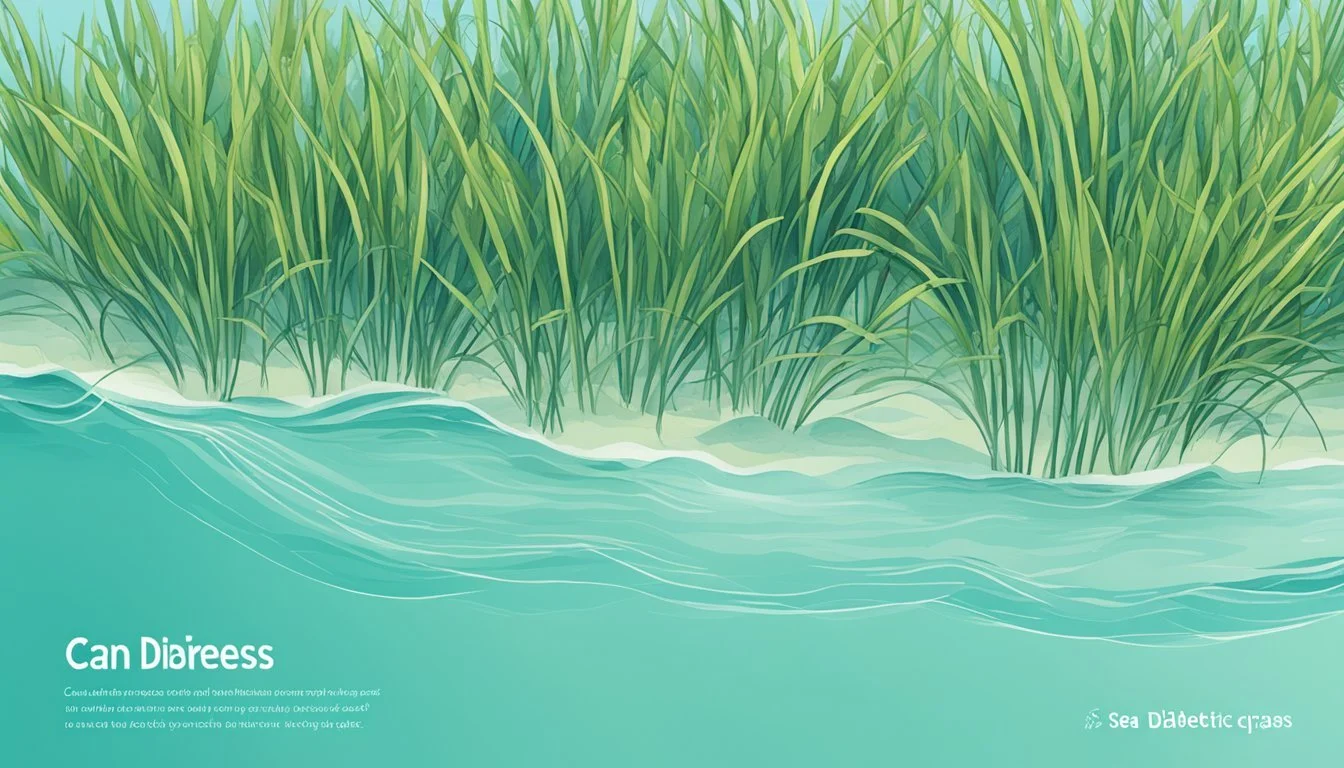Can Diabetics Eat Sea Grass?
Understanding Health Implications
Sea grass, often referred to as seaweed, has garnered attention for its numerous health benefits. For individuals managing diabetes, the potential impacts of incorporating sea grass into their diet are of particular interest. Yes, diabetics can eat sea grass, and it may offer specific benefits in managing their condition. Rich in essential nutrients, seaweed varieties such as nori, kelp, and wakame have properties that can aid in blood sugar regulation and overall metabolic health.
Sea grass is high in fiber, which can slow the absorption of carbohydrates, leading to more stable blood sugar levels. Additionally, it contains compounds that may improve insulin sensitivity. This makes seaweed a beneficial addition to a diabetic-friendly diet when consumed in appropriate portions.
Moreover, options like spirulina and chlorella offer a range of vitamins and minerals without adding significant calories, helping to maintain a balanced diet. The inclusion of sea grass not only adds nutritional variety but also supports the dietary needs of those managing diabetes effectively.
The Basics of Diabetes and Diet
Diabetes management heavily relies on a well-balanced diet. Key areas to focus on include diabetes, nutrition, blood sugar control, and a well-planned meal regimen.
Understanding Diabetes
Diabetes is a chronic condition characterized by high blood sugar levels. It occurs when the pancreas produces insufficient insulin or when the body cannot effectively use the insulin it produces.
Type 1 diabetes happens when the body fails to produce insulin, while type 2 diabetes arises from the body's ineffective use of insulin. Blood sugar spikes, if unmanaged, can lead to complications such as heart disease and nerve damage. Regular monitoring and medication, along with appropriate meal plans, are pivotal in managing diabetes.
Importance of Diet in Diabetes Management
Diet plays a crucial role in managing diabetes. A balanced diet helps regulate blood sugar levels and provides necessary nutrients. Key dietary components include carbohydrates, fiber, protein, and healthy fats. Carbs should be monitored carefully, as they have the most significant impact on blood sugar. Reducing sugary foods is essential.
Incorporating fiber slows sugar absorption, aiding in blood sugar control. Proteins, such as those from fish, poultry, and legumes, play a part in satiety and blood sugar regulation. Healthy fats, from sources like avocado and olive oil, contribute to overall well-being. Coordinated meal plans help maintain steady energy levels and prevent sudden spikes or drops in blood sugar.
Sea Grass and Nutritional Profile
Sea grass possesses various nutritional benefits, making it an appealing addition to diets, particularly for individuals managing diabetes. Its unique composition includes essential vitamins, minerals, and other nutrients.
Defining Sea Grass
Sea grass is a marine angiosperm found in coastal environments. Unlike seaweed, sea grass is a flowering plant, often forming dense underwater meadows. These meadows provide crucial habitats for marine life. Common types include Posidonia oceanica and Thalassia testudinum. Notably, these species are distinct from algae, offering different nutritional profiles and ecological roles.
Nutritional Content of Sea Grass
Sea grass is rich in protein and omega-6 fatty acids, making it a valuable food source. It contains significant levels of fiber, which aids in digestion and blood sugar regulation. Key vitamins in sea grass include Vitamin A, C, E, and K. Additionally, it offers vital minerals like iodine, calcium, and iron. This nutrient-rich profile supports overall health and is particularly beneficial for diabetic individuals.
Sea Grass in a Diabetic Diet
Sea grass can be a beneficial addition to the diet for individuals with diabetes. This section will discuss its glycemic index, its effects on blood sugar levels, and the appropriate portion sizes for consumption.
Glycemic Index of Sea Grass
The glycemic index (GI) of sea grass is relatively low. Foods with a low GI are beneficial for people with diabetes because they have a slower impact on blood sugar levels. Sea grass, such as seaweed, contains dietary fibers that help in slowing down the digestion process.
Example GI Values:
Seaweed (similar types): Low GI (under 55)
Including low-GI foods like sea grass can help in better management of type 2 diabetes by reducing the risk of sudden spikes in blood sugar levels.
How Sea Grass Affects Blood Sugar Levels
Sea grass impacts blood sugar levels primarily through its high fiber content. Dietary fibers, especially soluble fibers, slow the absorption of sugar into the bloodstream. This slow absorption is key for maintaining stable blood glucose levels.
With its rich mix of nutrients, including iodine and antioxidants, sea grass can offer additional health benefits. These nutrients can further support glucose metabolism and improve insulin sensitivity. Regular consumption may assist in better management of blood sugar levels for individuals with diabetes.
Portion Size and Consumption
When considering the incorporation of sea grass into a diabetic diet, portion size is crucial. Overconsumption can lead to potential issues, such as excessive iodine intake, which may affect thyroid function.
Recommended Portion Size:
1-2 tablespoons of dried or powdered sea grass per day
Moderation is important. Consulting with a healthcare provider can provide personalized advice for incorporating sea grass into a diabetic diet. Sea grass can be added to soups, salads, and even smoothies to make its inclusion easier in daily meals.
Incorporating Sea Grass into Meals
Sea grass is a nutrient-rich food that can offer various benefits for diabetics, including aiding blood sugar control. Knowing how to effectively use sea grass in meals can enhance both its nutritional value and culinary enjoyment.
Recipes with Sea Grass
Incorporating sea grass into everyday meals can be simple and rewarding. One popular way to use it is in salads. Toss fresh sea grass with mixed greens, cherry tomatoes, and a light vinaigrette for a refreshing dish.
Another option is to add it to soups. Sea grass can be added to a vegetable or miso soup for additional flavor and texture. Preparing a stir-fry is also ideal. Sauté sea grass with garlic, ginger, bell peppers, and tofu for a savory meal.
For special occasions, sea grass can be included in sushi rolls. Layer sea grass with rice, avocado, and fish, then roll it in nori for a nutritional boost. These recipes not only diversify your meal plan but also ensure servings rich in essential nutrients.
Raw vs. Cooked Sea Grass
The choice between using raw or cooked sea grass depends on personal preference and the desired nutrients. Raw sea grass retains more of its original vitamins and minerals, making it suitable for salads and cold dishes. Consuming it raw can ensure you get the most out of its natural properties.
Cooked sea grass, on the other hand, can be easier to digest for some individuals and still offers many benefits. Cooking methods like steaming, boiling, or sautéing can soften its texture and reduce potential digestive discomfort. In cooked forms, adding sea grass to soups, stir-fries, and even as a side dish can make it versatile.
Both raw and cooked options fit well within a balanced meal plan, providing the necessary servings to take full advantage of sea grass's health benefits.
Potential Health Benefits
Sea grass provides a variety of health benefits, particularly for managing diabetes, improving cardiovascular health, and assisting with weight management and obesity control. These benefits stem from its rich nutrient profile and bioactive compounds.
Impact on Diabetes Management
Sea grass may play a significant role in diabetes management. Studies indicate that certain types of sea grass can help regulate blood sugar levels. Brown seaweed, for instance, has shown the potential to reduce fasting blood glucose by nearly 16.5%.
Sea grass is also low in carbohydrates and calories, making it a diabetes-friendly food. The high fiber content in sea grass helps slow down the absorption of sugars, reducing blood sugar spikes after meals. Including sea grass in the diet could support better blood sugar control and overall diabetes management.
Cardiovascular Health
Consuming sea grass can be beneficial for cardiovascular health due to its high concentration of antioxidants, vitamins, and minerals. Sea grass contains iodine and tyrosine, which are essential for thyroid function but also support heart health.
Sea grass's fiber content helps lower cholesterol levels, reducing the risk of heart disease. It may also help regulate blood pressure, contributing to better cardiovascular health. With its nutrient-rich profile, sea grass can potentially lower the incidence of heart-related issues.
Weight Management and Obesity Control
Sea grass is an excellent addition to the diet for weight management and obesity control. Its low-calorie, nutrient-dense nature makes it an effective food for those looking to maintain or reduce weight. Spirulina and other types of sea grass are high in protein, promoting satiety and reducing overall calorie intake.
The fiber in sea grass supports digestive health and prolongs the feeling of fullness, thereby helping to manage weight more effectively. Incorporating sea grass into a balanced diet can assist in obesity prevention and weight maintenance efforts.
Risks and Precautions
When considering sea grass for diabetics, it's essential to focus on possible allergies and interactions with medications, as well as the importance of monitoring blood sugar levels after consumption.
Allergic Reactions and Interactions
Individuals sensitive to seafood may experience allergic reactions to sea grass. Symptoms can range from mild skin rashes to severe anaphylaxis. It's critical to consult with a healthcare provider before introducing sea grass to the diet, especially for those with known allergies.
Sea grass might interact with certain medications, particularly those for thyroid management and blood pressure regulation. For diabetics, interactions between sea grass and insulin must be monitored closely. Some types could potentially enhance or interfere with insulin absorption and efficacy.
Monitoring Blood Sugar After Ingestion
Diabetics should diligently monitor their blood sugar levels after consuming sea grass. Although sea grass is low in carbohydrates, its impact on blood sugar can vary depending on the individual and the quantity consumed.
Using a continuous glucose monitor or regular finger-stick tests can help track blood sugar fluctuations. Observing these trends can guide adjustments in diet or medication as needed.
Healthcare providers may recommend specific times for blood sugar testing post-consumption to identify any unusual spikes or drops. This vigilance ensures that any adverse effects are promptly addressed.
Conclusion
Sea grass can be a beneficial addition to a diabetic diet. Due to its high fiber content, it may help moderate blood sugar levels, which is essential for diabetes management.
It contains essential vitamins and minerals that contribute to a balanced diet. These include vitamins A and C, calcium, and magnesium, all of which support overall health.
For those managing diabetes, incorporating sea grass into meals can be done in various ways. It can be added to salads, soups, or even as a side dish.
Always consult a healthcare professional before making any significant dietary changes. This ensures that sea grass fits well within individualized meal plans, helping individuals maintain optimal health.







